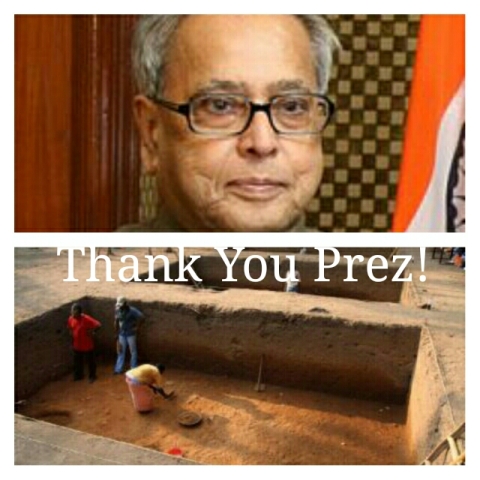President listened to Sane Voices, Blow to Legitimisation of St Thomas Myth

The last minute unexpected move made by President Pranab served a severe blow to the Marxist- Evangelical nexus, which was working overtime to legitimize and pass off as authentic, a fabricated chapter of Kerala history – St. Thomas Visit to Kerala.
Making last-minute changes in his schedule, Honourable President of India Pranab Mukherjee decided to skip his visit to the Muziris exhibition at Kodungalloor after inaugurating the Muziris Heritage Project on Saturday.
The change resulted from well founded doubts raised by Bharatiya Vichara Kendram regarding inclusion of Pattanam, near Paravur, in the Muziris project. Historian MGS Narayanan and the Bharatiya Vichara Kendram had questioned the authenticity of Pattanam excavations. They had also made a request to the President to stay away from the event.
Historian and former chief of the Indian Council for Historical Research (ICHR) MGS Narayanan has stated that Kerala Council for Historical Research (KCHR) had misled Kerala government into believing that the archaeological site at Pattanam, situated a few miles away from Kodungalloor, was the location of the ancient harbour of Muziris. “It’s unfortunate that they have now sought to drag the President into the controversy around the so-called Muziris project by including a visit to Pattanam in his itinerary,†he said. “The location of Muciri, called Muziris by Greek and Roman geographers, had already been clearly recorded by poets of the Sangam Age who mentioned Yavana (Roman) ships coming to Muciri at the mouth of the river Periyar, and going back laden with pepper after paying in gold. It is obvious that they were referring to Kodungalloor, the harbour town controlled by the Cheraman chieftains of Tamizhakam who had their headquarters in the interior, at Karur near Trichy,” he said.
MGS Narayanan said that these Cheramans could “easily reach the West Coast through nearby Palghat gap, and then follow the course of river to its end for taking advantage of the Roman trade. Muciri and Karur are both mentioned in Sangam literature,†the historian says.
From information provided by classical Greek and Roman writers Pliny, Ptolemy and the Periplus of the Erithrean Sea, the Greek and Roman navigators who came with the monsoon first cited Ezhi Mala and going southward reached Muziris, the first Emporium of India which, according to their calculation, lay 500 stadia to the South of Ezhi Mala.
Modern scholars have found this to be the location of Kodungalloor, which became the capital of the later Cheraman Perumals who renamed it as Makotai or Mahodayapura.
“It is clear by now that Pattanam which has yielded pieces of Roman amphorae, important potsherds and one or two old Cera punch-marked coins, and was at best a good archaeological site producing semi-precious carnelian and other beads in plenty, and presumably a small brick platform and a small piece of a wooden boat, cannot by any stretch of imagination be called Muziris,” says Narayanan.
Welcome to Haindava Keralam! Register for Free or Login as a privileged HK member to enjoy auto-approval of your comments and to receive periodic updates.
Latest Articles from Divisive Agenda
- എന്റെ സത്യാന്വേഷണം – ക്രിസ്തുമതത്തില് നിന്ന് ഹിന്ദുത്വത്തിലേക്ക്
- Apologize or Face the Consequences
- Rewards – Punishments – Heaven – Hell and Jihad
- State Sponsored Divisive Wall – A Look Back
- In’s and Out’s of Love Jihad
- Brutal Assaults, Death Threat Awaits your Kid, If not Ready to Join SFI
- SFI Blasphemy: Hindu Deities Denigrated in Kerala Varma College
- Pinarai Vijayan’s Comments on Yoga Stems from Inferiority Complex of a Commie
- HC Directive – Blow to Love Jihadis & ISIS Recruiters
- Irom Sharmila, welcome to Kerala!

